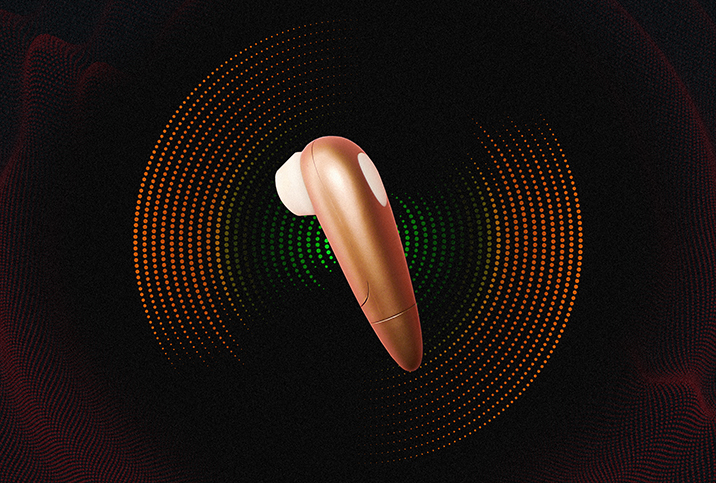Our Sex Drive Drives Technological Innovation

While there's no way to confirm how many major inventions were made with sex in mind, we do know of many technologies whose first (or a close second) use was sexual. Sex historian and author Hallie Lieberman said when it comes to replicating sex, humans are quite innovative.
"Anytime you have a new material, there [are] sexual uses for it," Lieberman explained. "Aluminum, for example. [In] the archives of the Smithsonian, aluminum is this new material coming out for all these things, and one of the things was a casing for a vibrator. Similarly, materials and small motors in the early 1900s were used for vacuums. And then they're like, 'Oh, we can use them for vibrators.'"
It should feel good and be safe
There's obviously a wide application for small, quiet motors and many items that require them, but their use in vibrators probably expedited their evolution. However, the technology doesn't just have to be good to catch on. As Lieberman explained, it has to feel good, too.
"Just because the technology works better doesn't mean people are going to want to use it, especially when it comes to sex," Lieberman said. "Fish bladders were really popular as condoms. When they were made of rubber, it was a lot less comfortable than animal products, and people didn't really want to use them. It's all about feel."
From a modern perspective, the choice between animal intestines and latex for a condom is an easy one. However, when the first rubber condoms were produced in 1855—a development made possible thanks to the discovery of the vulcanization process in 1839—they were thick and rigid. In that case, pleasure won and fish gut condoms remained the rage until technology caught up.
Logic doesn't always win out when unending sexual desire meets a free market. The sexual marketplace is littered with gimmicks, and despite innovation, they're not all bound to stay.
"The 'auto blow' was this device from the 1970s [that] plugged into your car and gave you a blow job," Lieberman said. "You don't see that on the market anymore, probably for safety reasons. Ads for sex dolls from the '70s said, 'She's the perfect woman—she cooks.' Obviously, she didn't cook; she was an inflatable thing with an eight-track recorder to moan."
Car safety tightened up in 1968 when seat belts became mandatory. Thus, the practice of using a cigarette lighter in a car to power an automated blowjob didn't last against a new interest in automotive safety. As for those eight-track moans: U.S. cassette player sales skyrocketed in the mid-1960s, meaning only a few years were required for the technology to be applied to sex dolls.
But the technology that sex has driven isn't just relegated to gimmicks such as giving inflatable women the power of (simulated and limited) speech.
Money makes the tech go around
"There's one argument that the whole adoption of the internet in people's homes is credited toward porn because it was young men who wanted to see naked images of women and were willing to spend the money," Lieberman said. "Internet porn pioneered being able to take credit card numbers online. Video streaming technological advances all came from internet porn. It's a lot of VR [virtual reality] stuff now—it wouldn't surprise me if deepfakes were pioneered by porn."
You only have to look at who was making money back in those early days of the internet. The "bubble" of the late 1990s burst in March 2000, and many sites never made it. But most porn sites did.
This represents one factor in making new tech readily available: popular use. The other factor is cost. To a certain population, the use of a fledgling internet for an unquenchable sexual appetite made the cost a secondary concern. For the less advantaged, such advances have to wait. Consider less wealthy people in the early 20th century who didn't have electricity in their homes—or the sexual pleasure that could accompany them.
"There were some bars, like [in] Battle Creek, Michigan, that had 'vibratory therapy' so if you really wanted to, you used a hand-crank [vibrator]," Lieberman said. "It gets to a bigger thing, which is: It's about wealth. The people who can afford to have an electrified home are the ones who get the new sexual technology. No different than today, looking at VR, at high-tech internet porn. People with fast broadband are the ones who can stream porn. And then the ones who don't have great internet access have to see the static pictures."
During the early 20th century, the biggest leap was for home electricity to become affordable to the general public. In the late 20th century, a similar progression occurred with home computers.
Lieberman described a less essential but, for some people, equally enticing iteration of teledildonics, that is, virtual sex encounters using tech to mimic and extend human sexual interaction.
"The new thing with VR [is] having it sync up with a performer as you've got the VR goggles on," she explained. "This is usually for men; getting your penis sleeve to link with their sexual movements. The forefront is working with cam girls and boys to have a superrealistic sexual experience."
It's getting better all the time
The incentive for progress may be purely financial, but Lieberman believes sex toys have a more altruistic future ahead, too.
"Disabled users [say] apps are very helpful. If you have an app-controlled sex toy, you can speak on your phone if your hands aren't working," she said. "[A] huge percentage [of people] have had mobility issues…It's a huge market out there, and that's why I think you're seeing more products for people with disabilities that are crossing over into people who may not think of themselves as disabled but [need] bigger buttons or have hand mobility issues."
'Disabled users [say] apps are very helpful. If you have an app-controlled sex toy, you can speak on your phone if your hands aren't working.'
But Bluetooth alone won't transform sex toys into pinnacles of inclusivity. Sexuality educator Jane Fleishman, Ph.D., explained that innovation has to be integrated into the very design of a product.
"If you had chronic pain in your back or in your joints and it just doesn't work anymore to do what you used to do…you need some adaptive material," Fleishman said. "That simply isn't the current state of most toys. [With] a lot of sex toys, you have to hold the button for three seconds, you have to read it, is this up or down?"
Where Fleishman sees the need to change conventional toys to be more accessible, Lieberman views cutting-edge sex tech as a way to create new categories of toys altogether.
"The Bump'n Joystick is this device created by a man who has spastic cerebral palsy," Lieberman said. "You hug the device because your hands and arms don't work so you can't control it [like] regular sex toys [where] other people work through hands and arms. You control it with your leg muscles, so you actually squeeze and control the movement. There's an older technology they're perfecting which is devices for men who've had spinal cord injuries that allow them to ejaculate; a certain high vibration will cause a man who doesn't have feelings for the bottom half of his body to ejaculate."
Whether it's making sex toys and apps for people with disabilities or some really realistic virtual reality scenes, humanity's big brains continue to serve our basest instincts.




















